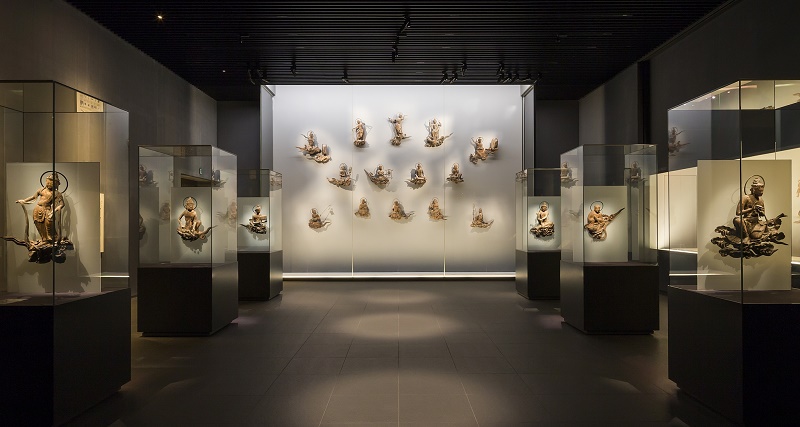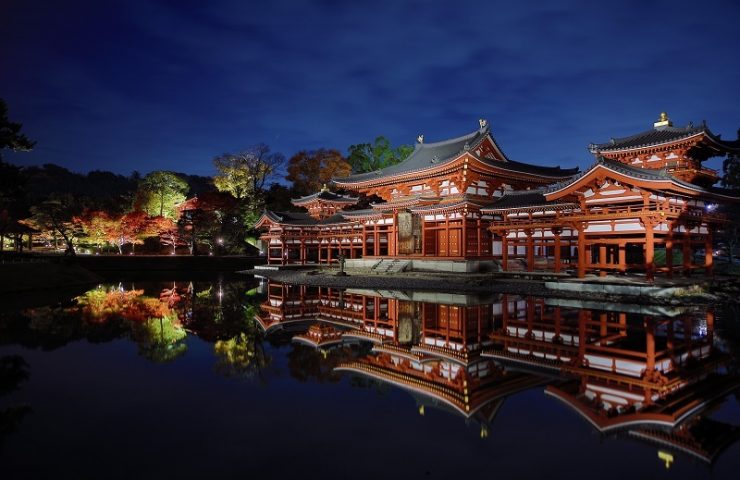OCTOBER is a vibrant time to experience the rise of autumnal tones and site colored by history in the Byodo-in Temple located in Uji City, near Kyoto, Japan. Here you can feel the spirit of Buddhist temple, beloved for an architecture of rich decorate elements. Edhie Rianto who visited there recently will revealed the story.
This temple was converted from a Fujiwara villa into a Buddhist temple in 1052. The “Phoenix Hall” (Houou-do), more properly known as the Amida-do, was built in 1053 and is the only original building remaining.
The main hall of Byodo-in Temple was built to emulate Buddha’s palace in paradise, and the temple is indeed otherworldly. Its graceful lines and warm colors give the building the appearance of a majestic bird spreading its wings. It is popularly known as the “Phoenix Hall,” and when seen with its reflection on the large pond in front, it almost appears to be gliding above the earth. This view is one of the most famous scenes in Japan.
Inside, the temple houses a statue of Amida Buddha, whose face catches the light of the morning sun. Surrounding him are graceful depictions of Boddhisattvas in a variety of poses, playing instruments or reading sutras. There is a lively quality to these smaller statues, which creates a fine contrast to the serenity of Amida. All are said to be the work of the priest and master sculptor, Jocho.
Other treasures of Byodo-in can be found in the Hosho-kan Museum, including the original temple bell, door paintings, and twin phoenix roof ornaments.
The temple dates from the 11th century, and began its life as a villa for the Fujiwara clan, regents to the Imperial throne. It is one of the few surviving examples of Heian Period (794-1185) architecture. Allow yourself about an hour to wander through the grounds and soak up the atmosphere. The approach to the temple is lined with souvenir shops, many of which serve local tea outside. A small packet of this tea is popular as a souvenir or gift.
For those of you who want to visit there, here is some information that might be useful for you; Byodo-in Temple address: 116 Uji-renge, Uji City, Uji, near Kyoto. Telephone: +81-(0)774-21-2861, Hours: 8:30 – 17:30 (No admission after 17:15), Access: 10-minute walk from JR Uji Station on the JR Nara Line 10-minute walk from Keihan Uji Station on the Keihan Railway Uji Line.

For entrance fees at the temple: Adults 600 yen, Junior High School Students 400 yen ad Elementary School Students 300 yen. Beautiful grounds and tranquil place to sit and be in the moment.
Well, if you look on the back of a Japanese 10 yen coin and you’ll see Byodoin Temple’s famous Hoodo Hall, also known as Amida Hall or Phoenix Hall. This building is one of the country’s most well-known examples of Buddhist architecture and the only original structure of the Byodoin Temple complex that remains today.
This originally a villa belonging to the Fujiwara clan, a powerful family of regents, Byodoin was converted to a Buddhist temple in 1052 and has operated since then. Hoodo was constructed the following year and has stood ever since.
The statue originating from China, the symbol of the phoenix is worshipped by Buddhists as Buddha’s protector. The shape of the Hoodo Hall references the form of the bird, and two bronze phoenixes sit atop the roof, facing each other in pleasing symmetry. Inside the hall sit a cedar statue of the Amida Buddha covered in gold leaf and accompanied by 52 bodhisattvas.
15-minute tours of the hall are the only way to see the ancient carvings, paintings, and Amida sculpture inside. Don’t worry, tours are not in Japanese only, but an English leaflet is available. Adjacent to the temple is the Hoshokan Museum. The museum exhibits the original temple bell and phoenix roof ornaments, as well as other treasures no longer in the main hall. [traveltext.id]
















